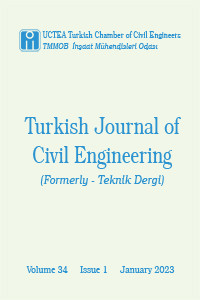Investigations of Exterior Wind Flow and Aerodynamic Coefficient around Y-Plan Shape Tall Building
Aerodynamic forces, Computational Fluid Dynamics (CFD), Wind tunnel, tall buildings
Investigations of Exterior Wind Flow and Aerodynamic Coefficient around Y-Plan Shape Tall Building
___
- [1] Yasushi Uematsu., Motohiko Yamada., Akira Inoue., Takeshi Hongo., Wind loads and wind-induced dynamic behavior of a single-layer latticed dome, J. of Wind Eng and Industrial Aerodynamics., 66(3), 227-248, 1997
- [2] G, M, Richardson., R, P, Hoxey., A, P, Robertson., J, L, Short., The Silsoe Structures Building: Comparisons of pressures measured at full scale and in two wind tunnels, J of Wind Eng and Industrial Aerodynamics., 72, 187-197, 1997
- [3] Chita Ganapathi, S., Harikrishna, P., Selvi Rajan, S., Effects of upstream terrain characteristics on aerodynamic coefficient of structures, Archives of Civil and Mechanical Engineering., 17(4), 776-785, 2017
- [4] Ben Mou., Bao-Jie He., Dong-Xue Zhao., Kwok wing Chau., Numerical simulation of the effects of building dimensional variation on wind pressure distribution, Engineering Application of Computational Fluid Mechanics., 11, 293-309, 2017
- [5] Gu, M., Quan, Y., Across-wind loads of typical tall buildings, J of Wind Eng and Industrial Aerodynamics., 92, 1147-1165, 2004
- [6] Zhao Liu., Chaorong Zheng., Yue Wu., Richard G.J. Flay., Kan Zhang., Investigation on the effects of twisted wind flow on the wind loads on a square section megatall building, J of Wind Eng and Industrial Aerodynamics., 191, 127-141, 2019
- [7] Ashutosh Sharma., Hemant Mittal., Ajay Gairola., Mitigation of wind load on tall building through aerodynamic modifications: Review, J. of Building Eng., 18, 180-194, 2018
- [8] Kim Y., Kanda J., Characteristics of aerodynamic forces and pressures on square plan buildings with height variations, J of Wind Eng and Industrial Aerodynamics., 98, 449-465, 2010
- [9] Biswarup Bhattacharyya., Sujit Kumar Dalui., Investigation of mean wind pressure on E plan shaped tall building. Wind and structures., 26(2), 99-114, 2018
- [10] Rajdip paul and Sujit kumar dalui, Wind effects on ’Z’ plan-shaped tall byulding: a case study, Int J Adv Struct Eng., 8, 319-335, 2016
- [11] W.P. Jones and B.E Launder, The prediction of laminarization with a two equation model of turbulance, Int. Journal of Heat and Mass transfer., 15, 301-314, 1972
- [12] Hargreaves, D, M., Wright, N, G., On the use of the k-? model in commercial CFD software to model the neutral atmospheric boundary layer, J of Wind Eng and Industrial Aerodynamics., 95, 355-369, 2007
- [13] Franke, J., Hellsten, A Schlunzen, K, H., Carissimo, B., The COST 732 Best practice Gudelines for CFD simulation of flow in urban Environment: A summary, International J of Environment and Pollution., 44, 419-427, 2011
- [14] Tominaga, Y., Mochida, A., Yoshie, R., Kataoka, H., Nozu, T., Yoshikawa M., Shirasawa, T., AIJ guidelines for practical application of CFD to pedestrian wind environment around building, J of Wind Eng and Industrial Aerodynamics., 96 (10-11), 1749-176, 2008
- [15] Peter Sachs., Wind forces in Engineering, 2nd Edition., Pergamon Press., 1978
- [16] Rajasekarababu, K., Vinayagamurthy, B., Selvi Rajan. S., Experimental and Computational investigation of outdoor wind flow around a setback building, Building Simulation., 12, 891-904, 2019
- [17] Zhao, X., Ding, J.M., Sun, H., Structural Design of Shanghai Tower for wind Loads, Procedia Engineering., 14, 1759-1767, 2011
- [18] Suresh Kumar, K., Wind loading on tall buildings: Review of Indian Standards and recommended amendments, J of Wind Eng and Industrial Aerodynamics., 204, 104240, 2020
- [19] Hellsten, A., Schunzen, K.H., Carissimo, B., (2007), Best Practice Guidelines for the CFD simulation of flow in the urban Environment, Brussels: COST office.
- [20] Y.C Kim, E.K Bandi, A.Yoshida, Y.Tamura, Response characteristics of super tall building – Effect of number of sides and helical angles, J of wind Eng and Industrial Aerodynamics., 145, 252-262, 2015
- [21] Jiming Xie, Aerodynamic optimization of super tall buildings and its effectiveness assessment. J of wind Eng and Industrial Aerodynamics., 130, 88-98, 2014
- [22] Eswara Kumar Bandi, Yukio Tamura, Akihito Yoshida, Yong Chul Kim, Qingshan Yang, Experimental investigation on aerodynamics characteristic of various triangular section high rise buildings., J of Wind Eng and Industrial Aerodynamics, 122, 60-68, 2013
- [23] Hideyuki Tanaka, Yukio Tamura, Kazuo Ohtake, Masayoshi Nakai, YongChul Kim, Eswara Kumar Bandi, Aerodynamic and Flow Characteristics of Tall buildings with various Unconventional Configurations, International Journal of High-Rise buildings., 2(3), 213-228, 2013.
- [24] Souvik Chakraborty, Sujit Kumar Dalui, Ashok Kumar Ahuja, Wind load on irregular plan shaped tall building – a case study, Wind and Structures., 19 (1), pp. 59-73, 2014.
- [25] Prasenjit Sanyal, Sujit Kumar Dalui, Effect of courtyard and opening on a rectangular plan shaped tall building under wind load, International Journal of Advanced Structural Eng., 10, 169-188, 2018
- [26] Amin, J.A, Ahuja, A.K., Characteristic of wind forces and responces of rectangular tall buildings, International Journal of Advanced Structural Eng., 6(66), 2018
- [27] Monalisa Mallick, Abinash Mohanta, AwadheshKumar, Vivek Raj, Modelling of wind pressure coefficient in C-shaped building models, Modelling and simulation in Eng., 6524945, 2018
- ISSN: 2822-6836
- Yayın Aralığı: Yılda 6 Sayı
- Başlangıç: 1990
- Yayıncı: TMMOB İnşaat Mühendisleri Odası
Critical Inclination of Failure Surface and Seismic Active Earth Thrust for a Broken Slope Backfill
Entropy Based Regional Precipitation Prediction in the Case of Gediz River Basin
Özgür BOZOĞLU, Türkay BARAN, Filiz BARBAROS
Determination of Finite Element Modelling Errors for Box Culverts Using Field Load Tests
Evaluation of Stripping Problem in Terms of Additive Types and Ratios in Asphalt Pavements
Celaleddin Ensar ŞENGÜL, Atakan AKSOY, Erol İSKENDER
An Investigation on Force Modification Factors in Cold-Formed Steel Structures
Investigations of Exterior Wind Flow and Aerodynamic Coefficient around Y-Plan Shape Tall Building
Multi Agent System Based Risk Allocation Model for Public-Private-Partnership Type Projects (RAMP3)
Effect of Sub-Contractor Selection on Construction Project Success in Turkey
